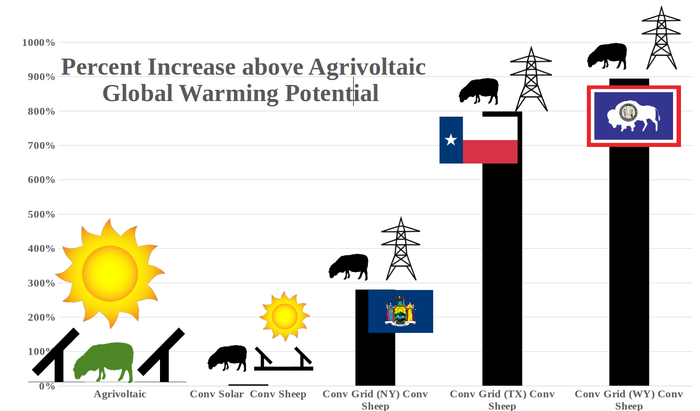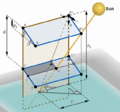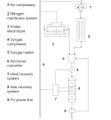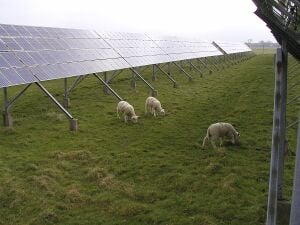
Solar photovoltaic (PV) growth can be stalled due to social acceptance. Agrivoltaics can improve social acceptance by enabling dual use of land. The most popular type of agrivoltaics in North America is grazing sheep under conventional PV farms. The environmental benefits of this integrated agrivoltaic system are unknown, so this ISO-compliant life cycle assessment study investigates the environmental performance of sheep-based agrivoltaic systems. This study investigated agrivoltaics to produce a combined output of electricity and agricultural goods, in comparison to conventional methods (various electric grid generation mixes in the U.S. and plane pastures) for producing that same quantify of service in both categories. Agrivoltaics is twice as land use efficient as providing sheep and PV services separately. In addition, the global warming potential of agrivoltaics was found to be 3.9% better than conventional PV and sheep grazing separately, and represents two orders of magnitude improvement (280%-894%) over conventional grids in the U.S. and sheep production. Only considering emission reductions from shifting sheep to PV farms for grazing, the U.S. could conserve 5.73E8 kg CO2 eq per year from sheep raising, which is equivalent to removing 117,000 average automobiles from the road. To house the current national 5.2 million domestic sheep in agrivoltaic systems, the U.S. has the potential to expand utility scale PV by a factor of four. The results of this study provide further evidence that agrivoltaic systems are superior to conventional ground-mounted PV systems because they have dual purposes and reduce the environmental impacts associated with producing food and electricity. It is clear that encouraging sheep grazing on all appropriate conventional PV systems is warranted.
Highlights[edit | edit source]
- Life cycle assessment of pasture-based agrivoltaic system (emissions & ecotoxicity)
- Comparison between 4 scenarios show agrivoltaics is superior to conventional practice
- CO₂ emissions and ecotoxicity quantified for sheep-based agrivoltaic system
- Integrated production results in 3.9% less emissions and 0.5% less energy demand
- Agrivoltaics vastly environmentally superior to grid-based electrical production in the US
In the News[edit | edit source]
- CBS ‘Saturday Morning’ Features AgriSolar Agrisolar Clearinghouse
- How "solar grazing" is creating a new industry CBS Morning
See also[edit | edit source]
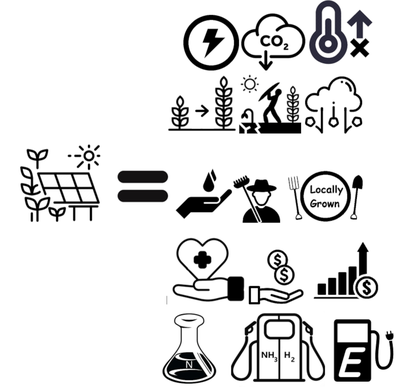
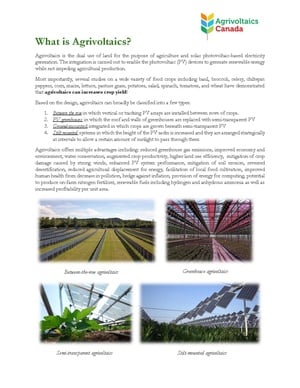
- Coal with Carbon Capture and Sequestration is not as Land Use Efficient as Solar Photovoltaic Technology for Climate Neutral Electricity Production
- Dual use of land for PV farms and agriculture literature review
- sheep
- Israeli white plastic reflectors
- A Farmer's Guide to Going Solar (NREL)
- German guidelines: https://www.ise.fraunhofer.de/content/dam/ise/en/documents/publications/studies/APV-Guideline.pdf
- 2021 review
- Miskin, C.K., Li, Y., Perna, A., Ellis, R.G., Grubbs, E.K., Bermel, P. and Agrawal, R., 2019. Sustainable co-production of food and solar power to relax land-use constraints. Nature Sustainability, 2(10), pp.972-980.
- Retrofitting solar parks for agrivoltaics
- Shading PV
- Alexis' talk at American Solar Grazing Association2021
In the News[edit source]
- Agrivoltaics: solar energy + better crops Climate and Nature
- Why solar power and farmers’ fields could be the perfect combination TVO
- Solar farms and sheep show the makings of a clean energy classic duo Business Renewables
- Agrivoltaics charge up St. Albert-area farms St Albert Gazette
- Sheep, solar and crops. How some Alberta farms are creating ideal growing conditions Western Wheel
- Sheep, solar and crops. How some Alberta farms create ideal growing conditions Voxpopuli
- 3D printed clamps for front-surface PV mounting on wood racking PV Magazine
- Harvesting the Sun to Grow in the Shade Garden Culture Magazine
- What crops fit with vertical agrivoltaics? PV Magazine
- Agrivoltaics – Keeping the farm in the solar farm Green Energy Futures
- Solar
- Papers
- Agrivoltaics
- Solar power
- Solar energy
- Photovoltaics
- Sustainable development
- Agriculture
- SDG02 Zero hunger
- SDG07 Affordable and clean energy
- SDG08 Decent work and economic growth
- SDG09 Industry innovation and infrastructure
- SDG12 Responsible consumption and production
- Energy
- Land use
- Energy policy
- Farming
- FAST Completed
- Sheep





